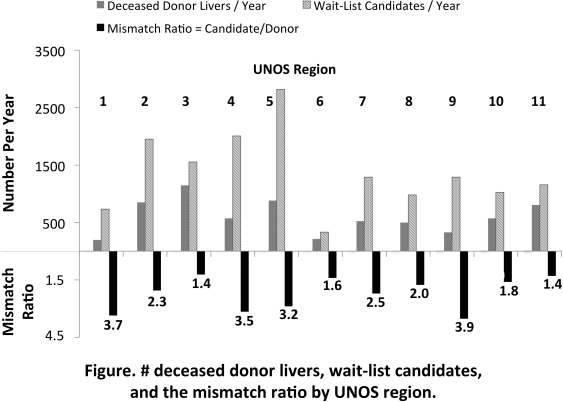Regional Mismatch Between Liver Supply and Demand: An Argument for a More Open Market
UCSF, San Francisco, CA.
Meeting: 2015 American Transplant Congress
Abstract number: 485
Keywords: Allocation, Liver transplantation
Session Information
Session Name: Concurrent Session: Liver Transplant Allocation Policy
Session Type: Concurrent Session
Date: Tuesday, May 5, 2015
Session Time: 4:00pm-5:30pm
 Presentation Time: 4:36pm-4:48pm
Presentation Time: 4:36pm-4:48pm
Location: Room 122-AB
Background: Geographic disparities in liver transplantation (LT) are well recognized. But the degree to which regional variation in deceased donor deficits contributes to wait-list mortality is poorly characterized.
Methods: Using UNOS data, all U.S. deceased donor livers from 2009-11 that were procured were identified. Livers were categorized by ABO group and UNOS region 1-11. A liver mismatch ratio for each region and blood type was calculated using the # candidates per donor. The liver donor recovery rate=livers procured/donors consented. Outcomes were MELD at transplant (LT-MELD) and the rate of death+delisting for being too sick for LT. Linear regression assessed relationships between the log2-transformed mismatch ratio and outcomes.
Results: From 2009-11, 19,770 deceased donor livers were available for the 45,401 LT wait-list candidates in the U.S. The number of livers and candidates per year by region are shown in Fig. There was significant variation in the mismatch ratio by region (p<0.01). For every doubling of the mismatch ratio, LT-MELD increased by 6 points for O, 7 points for A, 5 points for B, and 1 point for AB (p=0.07 for the ABO-mismatch interaction; R2=0.80). LT-MELD was not affected by regional liver recovery rates (coef -7.8, 95%CI -32.9-17.2). The %died/delisted per year ranged from 11-21% by region. A doubling of the mismatch ratio was associated with an average absolute increase in the death rate by 3.7% (R2=0.65). For example, UNOS region 9 had a mismatch ratio of 3.9 and 21% wait-list mortality rate, whereas UNOS region 3 had a mismatch ratio of 1.4 and 11% wait-list mortality rate.
There was significant variation in the mismatch ratio by region (p<0.01). For every doubling of the mismatch ratio, LT-MELD increased by 6 points for O, 7 points for A, 5 points for B, and 1 point for AB (p=0.07 for the ABO-mismatch interaction; R2=0.80). LT-MELD was not affected by regional liver recovery rates (coef -7.8, 95%CI -32.9-17.2). The %died/delisted per year ranged from 11-21% by region. A doubling of the mismatch ratio was associated with an average absolute increase in the death rate by 3.7% (R2=0.65). For example, UNOS region 9 had a mismatch ratio of 3.9 and 21% wait-list mortality rate, whereas UNOS region 3 had a mismatch ratio of 1.4 and 11% wait-list mortality rate.
Conclusion: Variation in mismatch between deceased donor liver availability relative to wait-list candidates by region and blood type accounts for 80% of the regional variation in LT-MELD and 65% of the regional variation in wait-list mortality rates. On a micro-level, specific data on the mismatch ratio by UNOS region can influence patients' decision to pursue live donor or listing at centers in regions with lower a mismatch ratio. On a macro-level, these data provide further justification for broader regional sharing to reduce mismatch in liver supply relative to demand.
To cite this abstract in AMA style:
Lai J, Sen S, Dodge J, Hayssen H, Roberts J. Regional Mismatch Between Liver Supply and Demand: An Argument for a More Open Market [abstract]. Am J Transplant. 2015; 15 (suppl 3). https://atcmeetingabstracts.com/abstract/regional-mismatch-between-liver-supply-and-demand-an-argument-for-a-more-open-market/. Accessed December 15, 2025.« Back to 2015 American Transplant Congress
